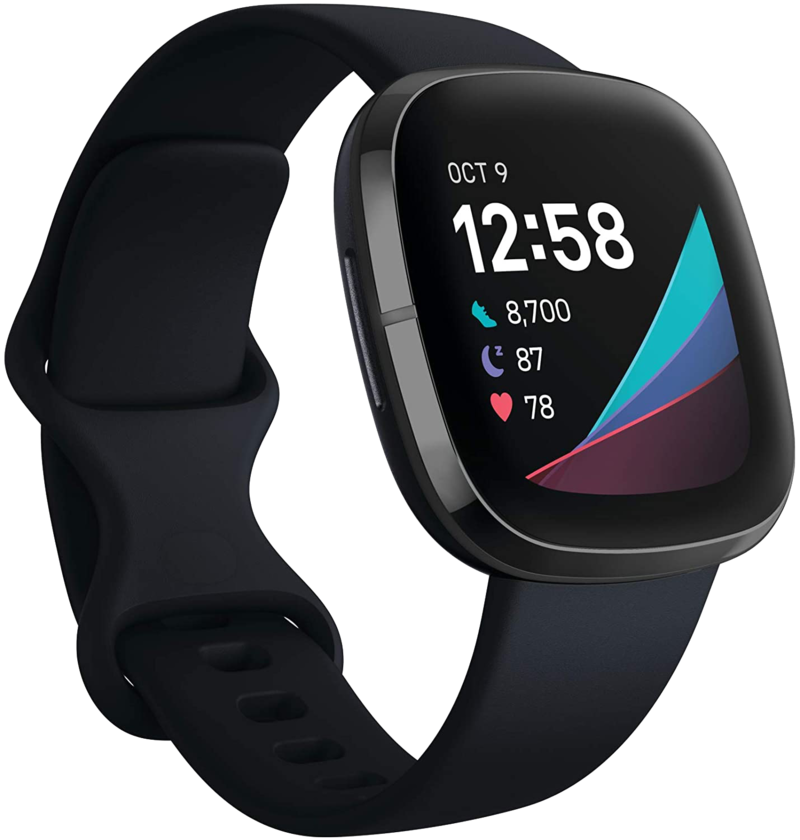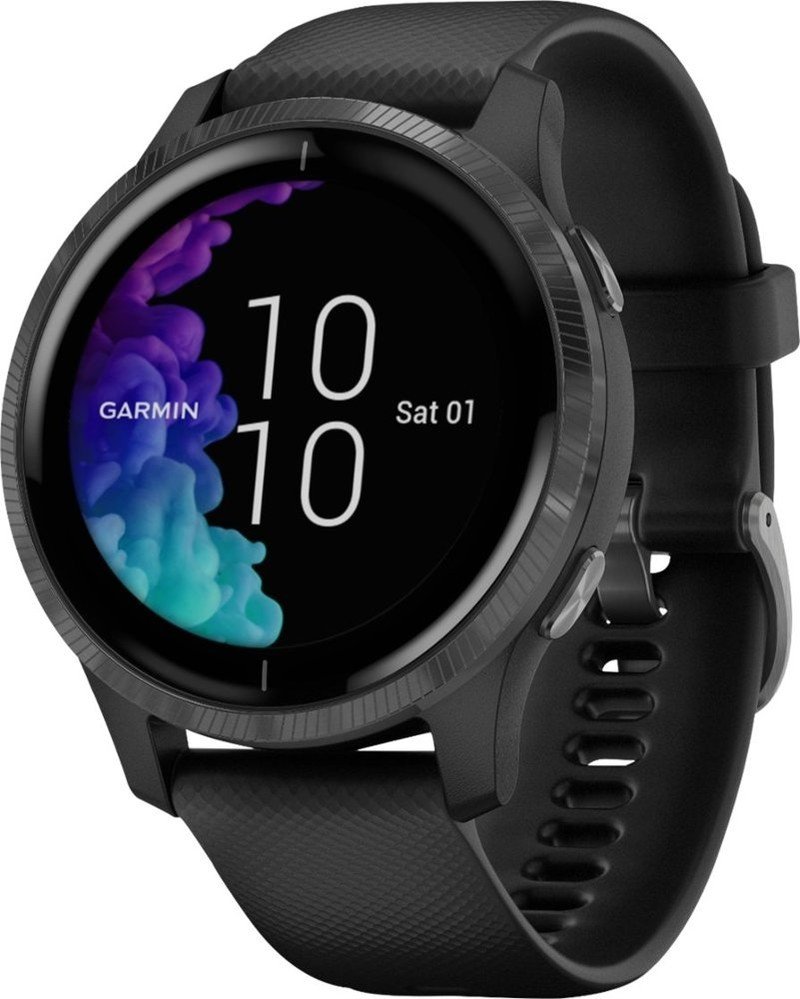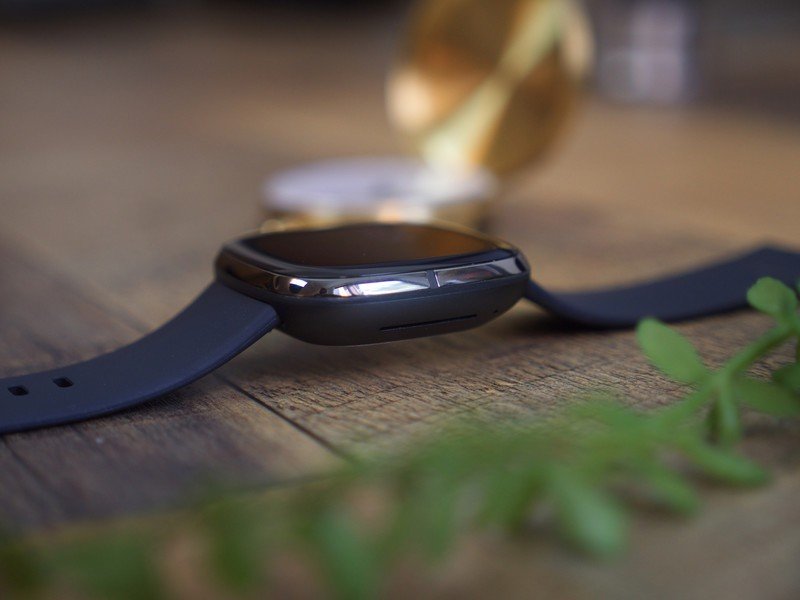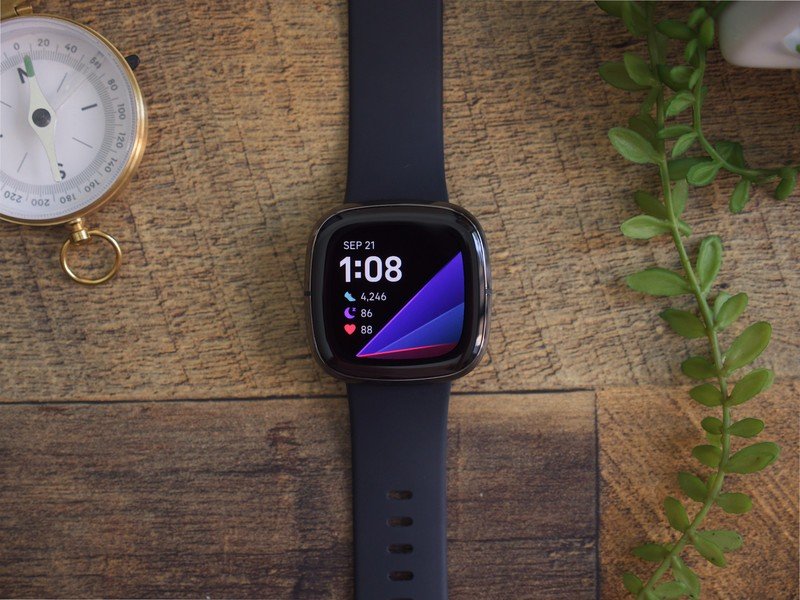Fitbit Sense vs. Garmin Venu: Which should you buy?

Fitbit Sense

If you're all about having all the details, you'll want to check out the Fitbit Sense. It costs a bit more than the Garmin Venu, but it allows you to learn important details about your overall well-being. You'll have new ECG and EDA sensors, onboard GPS, Active Zone Minutes, advanced heart rate technology, and more features.
Fitbit Sense
A closer look at your health
Garmin Venu

When you're buying a smartwatch to accompany your daily routine, you might prefer the Garmin Venu. It's not quite as advanced as the Fitbit Sense, but it covers most of the essentials. This stylish lifestyle watch will satisfy the fitness crowd with features such as onboard GPS, heart-rate monitoring, activity/sleep tracking, on-screen workouts, and more.
Garmin Venu
A perfect lifestyle watch
Fitbit Sense vs. Garmin Venu Comparing the two
When you compare the Fitbit Sense and the Garmin Venu, it's clear that they offer two very different designs. While there are plenty of other things that they do differently, there is some overlap worth noting. Either one of these devices will offer robust health and activity tracking, great battery life, and an attractive design.
The Fitbit Sense takes a much deeper dive into certain aspects of your health using advanced sensors, but the Garmin Venu does a good job of providing a broad overview. If you need as many details as possible, the Fitbit Sense has more to offer. If you don't mind keeping things a bit more simple, you might be perfectly content with the Garmin Venu.
The Fitbit Sense leaves no health questions unanswered

If you've already dabbled in the company's ecosystem, you might feel a wave of nostalgia come over you when you first see the Fitbit Sense. The design is almost an exact copy of what we've seen on the previous Versa watches. Although there are some noteworthy improvements that deserve recognition. For one, the watch case on the Fitbit Sense is made of both aerospace-grade aluminum and stainless steel. It also has a biosensor core that polishes things off with an alluring high-tech appearance.
Other than that, the Fitbit Sense is rocking an entirely new band system. If you experienced the nightmarish proprietary bands on the previous Versa models, you know that this change was necessary. The quick-release attachment system is smooth and simple, just how it should be. Swapping out your bands has never been so easy. Don't try to use your previous Fitbit bands on this watch, though, as they won't be compatible.
Out of all the new health sensors, the most exciting addition is the electrodermal activity (EDA) sensor. This feature is designed to measure electrodermal activity responses, which is helpful in learning about how your body responds to stress. It's easy to get an EDA reading on the Fitbit Sense, too. Place your palm over the face of the watch and it will start detecting small electrical changes in your skin's sweat level. Neat, huh?
Get the latest news from Android Central, your trusted companion in the world of Android
| Header Cell - Column 0 | Fitbit Sense | Garmin Venu |
|---|---|---|
| Display | 1.58" AMOLED | 1.2" AMOLED |
| Dimensions | 40 x 40 x 12mm | 43.2 x 43.2 x 12.4mm |
| Sensors | ECG, EDA, skin temperature, optical heart rate sensor, SpO2, gyroscope, 3-axis accelerometer, altimeter, ambient light sensor | Heart rate sensor, accelerometer, gyroscope, barometric altimeter, Pulse Ox, ambient light sensor |
| Connectivity | Bluetooth, Wi-Fi b/g/n | Bluetooth, ANT+, Wi-Fi |
| Water resistance | 5ATM | 5ATM |
| Battery life | 6+ days | 5 days |
| ECG & EDA | ✔️ | ❌ |
| Skin temperature | ✔️ | ❌ |
| Blood oxygen monitoring | ✔️ | ✔️ |
| NFC payments | ✔️ | ✔️ |
| Amazon Alexa & Google Assistant | ✔️ | ❌ |
| Mic/speaker | ✔️ | ❌ |

You also get a skin temperature sensor, which can detect changes that may potentially be a sign of a fever, illness, or the start of a new menstrual phase. The Fitbit Sense also checks the electrocardiogram (ECG) box, which is becoming a popular feature on health-focused smartwatches. This sensor analyzes your heart rhythm and can detect signs of atrial fibrillation (AFib). Once complete, you can download the reading and share it with your doctor.
Fitbit's new PurePulse 2.0 technology promises to deliver the most advanced heart-rate monitoring yet.
Fitbit's new PurePulse 2.0 technology promises to deliver the most advanced heart-rate monitoring yet. Another new feature is Active Zone Minutes, which alerts you when you've reached your personalized target heart rate zones during exercise. You'll also earn Active Zone Minutes for time spent in the cardio, fat burn, or peak heart-rate zones. Your personalized heart-rate zones are based on both your age and fitness level.
While we could go on and on about all the original goodies on the Fitbit Sense, just know that you'll have all the key features that these wearables are knowing for. Some examples include 24/7 heart-rate monitoring, activity tracking, sleep monitoring, several goal-based exercise modes, over six days of battery life, female health-tracking, Fitbit Pay, and Alexa.
The company has also added Google Assistant to the mix, which should be available soon. Another feature you can look forward to is the built-in mic/speaker, which allows you to handle Bluetooth calls and hear voice assistant responses on your wrist.
We can certainly appreciate how much effort Fitbit put into this revolutionary new device. However, it would've been nice to see some strides as far as FitbitOS is concerned. The operating system as well as the corresponding Fitbit app still experience sluggish performance and stability issues.
The Garmin Venu will take your breath away

What can we say about the Garmin Venu? For starters, it sure is nice to look at. It's one of the first Garmin wearables with a beautiful AMOLED display rather than the company's signature transflective display. While this may not be a big deal to some users, it provides a superior viewing experience along with an overall classier look and feel. Surprisingly enough, you can still get up to 5 days of battery life with typical usage. The watch comes in a luxurious 43mm stainless steel case with interchangeable bands.
The Garmin Venu offers over 20 preloaded sports apps or you can access preset workouts from Garmin Connect.
This watch might seem like it's all about looks, but you have access to some of the most essential features, like GPS, heart-rate monitoring, activity/sleep tracking, music storage, smartphone notifications, and mobile payments.
There's also more than one way to work out with your watch. The Garmin Venu offers over 20 preloaded sports apps or you can access preset workouts from Garmin Connect. There are also exclusive training plans available from Garmin Coach. If you're feeling creative, you can come up with your own customizable workouts.

You'll have a Pulse Ox sensor for monitoring blood oxygen saturation levels. Another unique feature is respiration tracking, which monitors the number of breaths you take per minute. These two features come together to provide you with more detailed sleep data. With built-in incident detection, your live location can be sent to your contacts if you fall or get injured. This can be done manually or the watch will do it automatically during select outdoor activities.
Another feature that users will find helpful on the Garmin Venu is Body Battery energy monitoring. This unique feature is designed to carefully monitor your energy levels during the day. Your watch will gather data from your sleep, stress, activity, and heart rate variability (HRV). This gives you a clear idea of when you should schedule rest time and activity time based on your energy levels.
Fitbit Sense vs. Garmin Venu Which should you buy?

Both of these smartwatches serve a purpose, so now all that's left to do is decide which purpose aligns most with your own. The Fitbit Sense is designed for users who want to take a much closer look at their health. Not only will you have all of the Fitbit perks you've enjoyed in the past, but you'll also have new sensors and features that help you keep your health in check. It's slightly more expensive than the Garmin Venu but for all the upgrades you get in return, it's worth it.
If you're purchasing a smartwatch for an entirely different reason, then you might not find the advanced health sensors to be all that intriguing. The Garmin Venu is a solid pick for those who want a lifestyle smartwatch that's fashionable and still offers plenty of useful features. Make no mistake, this is easily one of the best Garmin watches you can buy with GPS, heart-rate monitoring, activity/sleep tracking, smartphone notifications, music storage, and mobile payments.
Considering all the extras you get with the Fitbit Sense, it makes sense to pay a little extra for it. You'll get longer battery life, a mic/speaker to use for Bluetooth calls and voice assistant, and all of the other perks we've mentioned. It will be released on Sept. 25 and is available for pre-order now.

It's all in the details
Fitbit has set the bar high with its new advanced health smartwatch. The Fitbit Sense comes with key sensors that provide you with more insightful data. You'll also have GPS, activity/sleep tracking, Active Zone Minutes, and more. Don't worry, you'll still enjoy the other Fitbit perks you've come to know and love.

Far from ordinary
The Garmin Venu is a perfect lifestyle smartwatch that comes with a gorgeous AMOLED display, GPS, activity/sleep tracking, heart-rate monitoring, Body Battery energy monitoring, and much more. You'll also have music storage and mobile payments, which is a nice bonus when you're on the go.

Courtney Lynch is a freelance writer at Android Central. She's obsessed with all things health, fitness, and music. At any given time, she can be found checking out the latest and greatest gadgets while simultaneously petting her dog and sipping iced coffee.
